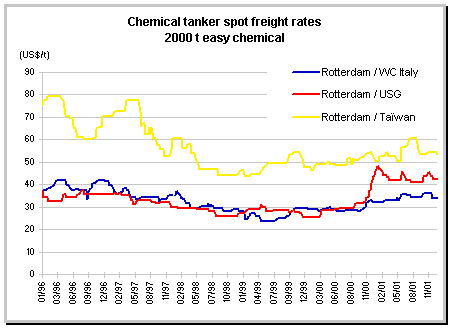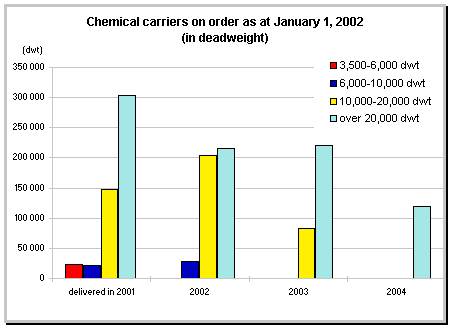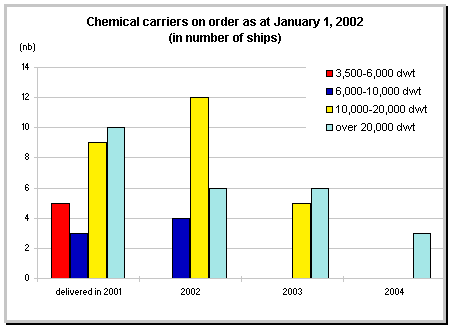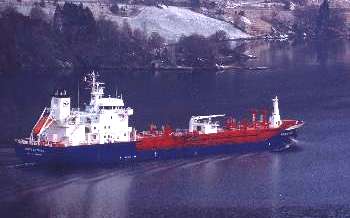
|
The Chemical Carrier Market in 2001 |
|
|
|
|
After experiencing a morose period over the
last four or five years, characterised by very low freight rates and an
important surplus of supply over demand, the chemical carrier market
started moving up during the fourth quarter of 2000. This tendency
continued at the start of the year 2001 practically without interruption
until the month of September. The tragic events of September 11th in the
United States brought about an abrupt halt to spot activity throughout
all markets and at the end of the year, as we write, no recovery has
really manifested itself. Nonetheless, it should be noted that all
through the year and even after the events of September, term contracts
have remained extremely active and have allowed owners a comfortable
level of employment for their vessels.
The year 2001 has also given rise to an overall improvement of the
financial standings of the main owners and operators, which is a
significant achievement. It has been quite a time since such a situation
has occurred.
The financial results posted by the main operators over the first six
months of the year give an idea of the magnitude on the increase in
freight rates as compared to 2000. Stolt-Nielsen showed a 64 %
improvement on turnover over the first two quarters and Odfjell-Seachem
40 % over the same period.
The general improvement this year in the chemical sector can be
explained by both structural and temporary reasons.
From a purely structural point of view, whereas the market over the
last few years was suffering from a chronic imbalance due to the
important surplus tonnage, the year 2001 gave place to a more balanced
situation often in favour of owners with demand in certain markets being
in excess of vessel availability.
Freight rates have logically benefited from this better balance. The
rise registered already in the first quarter, carried on right up to the
end of the second quarter, then marked a pause during the summer months.
The slowing down of the world economy, particularly in America which
plays such a prominent role, made itself felt at the middle of the year,
and the resulting drop in demand mainly for voyages from the US Gulf,
led to a substantial drop in spot rates at this time. These lower levels
have spread throughout all markets following the events of September
11th. However, the overall balance in supply and demand which exists and
seems not to be under threat for the next three years means that the
petrochemical sector, in contrast to others such as the dry bulk,
containers and tankers which have all seen plunging rates, has freight
levels which have levelled out but without any appreciable drop.
Another structural change which has contributed to the general
improvement of the market has been the rationalisation within the
chemical carriers, put in place by owners several years ago in order to
reduce costs and to adapt to the new regulations and ever more stringent
requirements in terms of security and efficiency. Mention should be made
of the agreement between Stolt-Nielsen and Tokyo Marine on the routes to
the Far East done in order to reduce the competition and the risks of
port delays.
Other factors but of a temporary nature also contributed to the
positive improvement of financial results for owners this year. On the
one hand the continuous drop in crude oil prices which have gone from
$24 per barrel at the beginning of the year to finish at $18 at the end,
has resulted in lower bunker prices and thus lower operating costs. On
the other hand, the strong dollar in relation to European currencies has
helped European owners and has also had a beneficial effect on their
financial results.
Clearly at year's end, uncertainties as to the future of the
chemical carrier sector exist. These uncertainties lie mainly in the
increases for insurance premiums to be applied for next year on hull
& machinery, the P&I Clubs or risk premiums paid out to the
crews, but above all on the timing and the extent of the recovery in the
world economy.
|
| Freight rates |
|
|
The North European market maintained a good
level of freight rates with a steady increase right up till the third
quarter, thanks to the solid covering on term business and a
well-sustained spot market. At the end of the year, a significant drop
in rates came with the slow-down in spot activity, but generally it was
a good year for owners with rates rising by some 10 / 20 %.
Inter-Mediterranean activity has become a two-tiered market
distinguished by some charterers requiring only quality ships, with the
result that good modern vessels have obtained substantially higher
levels.
The North European short-sea traffic, movements to and from the
Mediterranean, have experienced significant fluctuations in the volumes
and freight rates, with notably a strong demand in the first quarter in
the northbound voyages and then in the second quarter on the southbound
voyages. Rates increased by as much as 20 % in the peak period and by
some 10 % on average over the year, which has resulted for 3,000 ton
chemical lots in freights at around $30 per ton for cargoes into the Med
and some $27 / 28 per ton on the Med / North Europe leg.
On movements from US to Europe, the market has remained quiet up
until September, despite certain occasional variations. Since the events
of September 11th, spot activity has slowed down considerably, in
particular for "trading" cargoes. The contract nominations
however have been kept at a high level throughout the year, even despite
a slight reduction since the month of September.
In the beginning of the year freight rates for easy chemical lots of
3,000 tons between Houston and Rotterdam stayed at the levels that they
experienced at the end of 2000, namely in a bracket between $37 / 39 per
ton. At the end of the first quarter, rates dropped down to $35 per ton
and steadied out at this level until the middle of the summer.
The drop registered at this time worsened with the slowing down of
the American economy and the events in New York in September, to achieve
a level of about $33 per ton at the end of the year.
On movements from Europe to US, the market continued to rise during
the first quarter with a peak coming in March / April 2001. Big parcel
lots of oil products and MTBE started seeing lower rates as from May
onwards and this tendency carried on up until the end of the year.
Cargoes of chemical products however have remained at healthy levels
both in terms of volume and rates right through the year.
For 5,000 / 7,000 ton lots of easy chemicals from Rotterdam to
Houston, freight rates went from $29 per ton at the start of the year up
to $39 per ton in March / April and have settled down since May to a
level of $32 / 35 per ton.
Traffic from Europe into the main ports of S.E. Asia has been on the
increase and freight rates have also risen considerably over the year,
with a high at the end of the summer. Four main owners share this
market, covering for the most part contracts in the hands of
industrialists.
On the spot market rates for lots of 1,000 tons requiring stainless
steel tanks have increased by some 20 %, for example out of Rotterdam
into Singapore, Korea, and Taiwan the market has gone from $55 per ton
to $65 per ton.
Nonetheless it should also be noted that at year's end the fall-off
in activity linked to a policy of wait-and-see, in particular by China
and her Asian interests, preferring to hold off for the cost of raw
materials to drop further before restocking. The events of September
11th as well as the over-optimism in the demand forecast have also
provoked a lack of confidence with exporters of chemical products.
This slow-down has brought with it a drop in the market which is now
back to the freight rates that were seen at the end of last year.
|

|
| The fleet |
|
A slower rate of increase in the chemical
carriers fleet which began during the past two years has continued in
2001. It results from the dramatic drop in new orders placed by the main
operators since 1999, pursued in 2000 and maintained this year. The
important fleet modernisation programme undertaken in the years 1995-1998
had as consequence a plethora of new tonnage coming into service during
the years 1997-1999. The protracted depression in chemical carriers
resulting from the Asian crisis of 1997 combined with the excess tonnage,
seems at last to have caused owners to be more prudent when investing. The
declining rate in the increase of the fleet is however offset by the very
low level of scrapping. The drop in the number of vessels on order would
have been even more significant without the delay in delivery dates of a
number of ships in certain shipyards, which are experiencing technical
problems in completing orders.
|

|

|
|
Since the beginning of the year, 22 vessels
for 406,000 dwt have come into service, compared to 78 vessels for more
than 1 million dwt delivered in 1998, or 44 chemical carriers for 800,000
dwt delivered last year. The average size of these ships is 18,500 dwt. To
this total however, three vessels of 59,000 tons should be added which are
due for delivery by the end of the year but will probably slip into 2002
for two of them. The orderbook for the end of 2001 amounts to 39 ships for
960,000 dwt. The majority of orders do not extend beyond 2003. New orders
placed this year have gone mainly to the Japanese who have offered
relatively prompt deliveries: 22 vessels for 448,000 dwt are foreseen to
come into service in 2002, and nine vessels for 267,000 dwt in 2003, the
balance being the delayed orders placed in Poland for the account of
Odfjell-Seachem. This year none of the main chemical carrier operators
have placed orders and essentially new orders have come from Japanese
operators such as Iino Kaiun who have invested in new ships to replace
older units.
The level of scrapping has remained extremely low. It is unfortunately
a recurring theme in this sector which is preventing a steady elimination
of the oldest units. Since January 2001 only six vessels for 32,720 dwt
have been sent to the scrapyards. These figures are to be compared with
last year's eight ships for 93,000 dwt and in 1999 with only three for
7,200 dwt.
As we mentioned last year, in addition to vessels dedicated to
transporting chemicals, there is a growing number of coated product
tankers, classified IMO II or III, which can be added and whose orders
have virtually exploded since the 'Erika' incident of 1999. In the
25,000 / 50,000 dwt size category, no less than 220 vessels for 9 million
dwt are on order and 35 for 1.3 million dwt have been delivered since
January. These ships can potentially compete with the stainless ships for
transporting easy chemicals. Nonetheless, one can say that the chemical
carrier fleet is in the process of getting into better shape.
|
|
* * *
Globally despite the rather pessimistic economic forecasts for 2002,
the chemical carrier sector seems well placed to face the difficulties
that lie ahead in the coming months. According to the experts, the
slowing down of the economy should produce a pause in the trend towards
higher freight rates in this sector for next year, and consequently give
reduced returns in the short term for the main operators.
The downturn in the economy will probably bring about certain changes
in the flow of traffic, but on the whole demand is healthy and should
even see a slight increase of 4 % for next year, above the increase in
supply which is planned to be about 2 % in 2002.
We do not foresee an important risk of over-capacity of tonnage over
the next few years, except in the case of a collapse in the product
tanker market which could then hypothetically look for work within the
chemical carrier trade. On balance we believe that freight rates should
stabilise over the coming months before starting to pick up again with
the predicted, or at least hoped for, recovery of the world economy in
the second half of 2002.
|
 |
Pointe du Croisic
6,500 dwt, blt 2001 by Kleven Flor', owned by Navale Fran'aise |
|
|
The
second-hand market for small product tankers and chemical carriers
|
|
|
The lack of interest posted by the large
chemical charterers and even more markedly the oil Majors for
single-hulled vessels has been the most notable aspect of the year 2001.
It helped push up the value of the rare double-hulled vessels being
offered second-hand. We can give as examples the 'Sioux' built in
1981 (6,400 dwt, coated / coiled) which went for the sum of $3 million,
the 'Bacalan' (11,500 dwt, built in Finland in 1982, coated / coiled
/ ice class) sold for $8 million and the 'Trelsi' built in 1991
(15,000 dwt, 17,000 cbm, coated / coiled) sold for $16.5 million.
2001 was thus a year, which was orientated principally towards
newbuilding of small product tankers (between 5,000 and 15,000 tons).
Turkish shipyards were able to offer numerous resales available for
fairly prompt delivery, amongst which were the 'Pyla', the 'Clipper
Legend' and the 'Clipper Leader' (10,000 dwt, 12,000 cbm) and the
'Sukran C' (4,700 dwt).
Nonetheless, the number of second-hand sales was considerably higher,
which goes to show that it is always possible to find buyers who are
looking for valuable employment of ships, be it even single-hull, as
long as the price is right. We can illustrate this with the sale to
Aksay of two chemical carriers the 'San Mateo' and the 'San Pedro'
(11,300 dwt, stainless steel and zinc coated, built in 1988) for $10
million en bloc.
In general it can be said that 2001 is in the post-'Erika' era
characterised by a marked acceleration of the fleet's renewal with a
confirmed preference by charterers for the 10,000 / 15 000 tons size
category.
If we were to judge the chemical carrier market solely within its own
confines and criteria, we could conclude that the offer and demand of
tonnage is in better balance than two years ago. This is borne out by a
firming up of freight rates since the end of 2000. However, we should
also take into account the growing number of product tankers which are
also suitable for chemical cargoes (as can be witnessed by the numerous
product/chemical carriers of 35 / 45,000 tons, ordered in Korea or
Croatia this year). The decline in rates, which we are experiencing
currently in the sector of product tankers, could weigh indirectly on
that of the chemical traffic which is exposed to these ships. We expect
in consequence that ships above 20,000 tons in the oil market and the
easy chemical sector will play an increasingly reciprocal role as a
balancing factor in the coming years, even if in general the chemical
carrier market will remain less volatile than that of the products which
is more exposed to the spot market.
For vessels under this size category, the prospects are good given
the distance still to be covered before a renewal of the fleet meets the
growing requirements of the oil charterers and the lack of flexibility
of demand in this segment of the market. Once again the proverb of
Florian will prove to be true, namely that "To live happily, be
discreet".
|
Shipping and Shipbuilding Markets in 2001
I N D E X
|